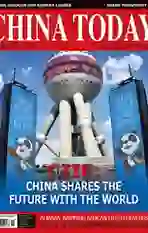Creators:Glory and Road
2018-11-21
Creators: Glory and Road
Life Weekly
Issue No. 40, 2018
Chinas reform and opening-up has achieved amazing results in the past 40 years, but the process has not been smooth.
Having learnt from the lessons gained in the first few years of reform and opening-up, China gained a clearer understanding of the direction it needed to take. The Third Plenary Session of the 12th Central Committee of the Communist Party of China (CPC) in 1984 adopted the CPC Central Committees Decision on Economic Restructuring, which confirmed the status of the commodity economy for the first time, a milestone in Chinas reform and opening-up drive.
In the early years, the vitality of reform and opening-up was mainly seen in the countryside. With the increasing intensity of ideological emancipation, the understanding of reform became increasingly profound, and this vitality spread on a larger scale across the country. The establishment of special economic zones enabled the Chinese economy to open up and embrace foreign investment. Its accession to the World Trade Organization in 2001 further integrated China into the world economy, bringing great changes, both domestically and globally.
From 1978 to 2017, Chinas GDP grew at an average annual rate of 9.5 percent, increasing 34-fold in total and becoming the worlds second largest in the process. However, the global ranking of the countrys per capita GDP stands at around 70th. China still has a long way to go to realize national rejuvenation.
Foreign Investment
China Financial Weekly
Issue No. 20, 2018
Deng Xiaoping, at the age of 74, visited seven countries in 1978, and Singapore was the last stop. Seeking to learn lessons in modernization was an important reason for his visit to Singapore. He was most impressed by Singapores openingup of its economy and attracting investment.
In late 1978, at the Third Plenary Session of the 11th CPC Central Committee, a major decision was made to implement reform and opening-up. In July 1979, China promulgated the first law on the use of foreign capital, and the Law on Chinese-Foreign Joint Ventures, which was a key step in opening its economy to the outside world. Since then, many foreign-funded enterprises have entered China.
The last 40 years prove that reform and opening-up is a pioneering undertaking of mutual benefit and win-win results. Foreign-funded enterprises have boarded Chinas economic express train and gained a huge market. Foreign investment has also contributed to Chinas world-famous development miracle.
Facing the future, as an important force to help Chinas development, foreign investment is still highly anticipated and will see more development opportunities.
In 2013, President Xi Jinping proposed the Belt and Road Initiative to further share the development dividend with the world through opening-up at a higher level. On important occasions such as the 19th CPC National Congress and the Boao Forum for Asia Annual Conference 2018, Xi repeatedly stressed that China will open its door wider.
Emergency Rescue for SMEs
South Reviews
Issue No. 20, 2018
In the Chinese economy, large state-owned enterprises (SOEs) are considered to be of great importance. In fact, given the status quo of Chinas social structure and the particularity of its financial system, small and medium enterprises(SME) are also important. But in recent years, Chinas SME community has experienced many challenges.
Recently, the government has increasingly recognized the importance of SMEs in China, and various reform and support measures have been launched to assist the more than 70 million SMEs in the country.
Data show that as of the end of 2017, SMEs (including privately or individually owned businesses) accounted for more than 90 percent of all market entities in China, contributing more than 80 percent of jobs, more than 70 percent of invention patents, more than 60 percent of GDP, and more than 50 percent of taxes.
To support SMEs, tax reductions are important. In the past five years, China has implemented a policy to replace business tax with value-added tax, leading to tax cuts of RMB 2.1 trillion. Plus tax incentives for SMEs and the exemption of various fees, the total tax reduction exceeded RMB 3 trillion.
But there is another important issue to be solved. SMEs are generally at a disadvantage in applying bank loans, which is the cause of the exstential threat for many of them. To address the “dual-track”credit system for SOEs and SMEs, deeper reforms are needed.
In Heritage Sites
New Weekly
Issue No. 19, 2018
To date, China has 53 sites inscribed on the UNESCO World Heritage list, second now only to Italy. The latest addition to this list is Mount Fanjing in Guizhou Province. The Forbidden City in Beijing is one of the most popular world cultural heritages in the world.
Today, people are fortunate to be able to visit and appreciate these ancient sites that have survived warfare, plunder, natural disasters, erosion, and destructive repair.
According to Irina Bokova, former director-general of the UN Educational, Scientific, and Cultural Organization(UNESCO), cultural heritage is not just stone and architecture, but also value, identity, and belonging.
Since 1844, many Westerners have recorded photographic images of China, leaving behind precious firsthand visual accounts of what the country was really like at the time.
According to Ernst Boerschmann, a German architect, photographer, and sinologist, only the past is unchangeable and clearly identifiable. Only in history can we learn to understand the unpredictability of life.
Witnessing the truth of history in historical sites raises ones understanding beyond that of the average tourist.
